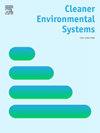解决用户行为不确定性的新系统的概率生命周期方法:在厕所中的应用
IF 4.9
Q2 ENGINEERING, ENVIRONMENTAL
引用次数: 0
摘要
对于严重依赖于用户配置文件的产品系统,例如建筑物、车辆、HVAC(供暖、通风和空调)系统或厕所系统,在使用阶段评估环境影响可能具有挑战性,这可能是生命周期影响的主要贡献者。用户行为的不确定性在生命周期评估研究中没有得到充分的解决。本文的目标是双重的:i)提出一种概率生命周期方法,该方法结合了用户行为场景分析、两两比较分析和全局敏感性分析;ii)将这种方法应用于一种新型厕所系统(WashOne),与传统系统(厕所和坐浴盆)进行比较。采用确定性使用模式和随机场景(由于组合不确定参数)的组合。两两比较指标的结果不确定,表明WashOne在所有类别中对环境的影响都明显低于传统系统。全局敏感性分析(使用Spearman秩相关系数)结果显示,厕纸(在传统系统中)和马桶使用(在新型系统中)对影响的影响最为显著。本文的结论是:(i)与传统系统相比,很大程度上依赖于用户偏好的新系统可以减少影响,(ii)它强调,随着产品系统被设计得更高效,用户行为的影响力会变小。本文章由计算机程序翻译,如有差异,请以英文原文为准。
Probabilistic life cycle approach for novel systems addressing user-behavior uncertainty: application to toilets
For product systems that heavily rely on user profiles, such as buildings, vehicles, HVAC (heating, ventilation, and air conditioning) systems, or toilet systems, estimating environmental impacts during the use phase can be challenging, which can be a major contributor to life cycle impacts. User-behavior uncertainty has not been sufficiently addressed in life cycle assessment studies. The goal of this article is twofold: i) to propose a probabilistic life cycle approach that combines user-behavior scenario analysis, pairwise comparative analysis, and global sensitivity analysis, and ii) to apply this approach to a novel toilet system (WashOne) for comparison with a conventional system (toilet and bidet). A combination of deterministic usage patterns and stochastic scenarios (as a result of combining uncertain parameters) was employed. A pairwise comparison indicator presents uncertain results, indicating that the WashOne has significantly lower environmental impacts than the conventional system in all categories. Results from the global sensitivity analysis (using Spearman Rank Correlation Coefficient) show that toilet paper (in the conventional system) and washlet use (in the novel system) have the most significant effect on the impacts. This article concludes that (i) novel systems that greatly depend on user preferences can reduce impacts compared to conventional systems, and (ii) it highlights that user behavior becomes less influential as product systems are designed to be more efficient.
求助全文
通过发布文献求助,成功后即可免费获取论文全文。
去求助
来源期刊

Cleaner Environmental Systems
Environmental Science-Environmental Science (miscellaneous)
CiteScore
7.80
自引率
0.00%
发文量
32
审稿时长
52 days
 求助内容:
求助内容: 应助结果提醒方式:
应助结果提醒方式:


